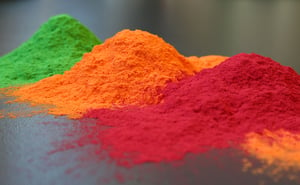 Marlin Steel manufactures custom wire forms that use polymer coatings to enhance their resistance to specific chemicals, or to protect parts from being scuffed by a solid metal surface. Recently, a manufacturer specializing in metal stamping, etching, and plating processes reached out to Marlin for a custom wire basket for holding parts through both ultrasonic cleaning and solvent-based vapor-cleaning processes.
Marlin Steel manufactures custom wire forms that use polymer coatings to enhance their resistance to specific chemicals, or to protect parts from being scuffed by a solid metal surface. Recently, a manufacturer specializing in metal stamping, etching, and plating processes reached out to Marlin for a custom wire basket for holding parts through both ultrasonic cleaning and solvent-based vapor-cleaning processes.
The parts that the basket would hold included a series of metal plates that were 9.14” x 6.88” x 0.002”. Each basket needed to hold 50 of these plates in place through parts washing processes while meeting tolerances of +/- 0.1”.
In this application, the client specified a desire for a Halar coating. What is Halar, and how did it affect the design and performance of this coated wire basket?
What is Halar?
Halar is a copolymer of ethylene and chlorotrifluoroethylene (abbreviated as ECTFE) that is the intellectual property of Solvay Solexis, a Belgian chemical company. Solvay Solexis offers a few variations of this coating material, but some general characteristics include:
- Having high and broad chemical resistance;
- Possessing a semi-soft surface;
- Having a relatively high operating temperature—it melts at about 255˚C (491˚F) and is recommended for consistent use at temperatures around 150˚C (302˚F);
- Being easy to bond; and
- Having extremely low permeability.
The chemical resistance and low permeability (less than 0.1% water absorption when submerged) makes Halar particularly effective at insulating custom wire baskets against chemical corrosion. In this case, however, the material’s semi-soft surface was its most desirable feature, as that would help prevent the scratching and scuffing of parts during ultrasonic cavitation.
How Halar is Applied to a Wire Basket
Halar coatings can be applied to a custom wire form in two ways:
- Electrostatic Powder Coating. This coating method involves spraying electrically-charged powder onto a grounded metal form. After application, the Halar coating is cured in an oven to strengthen it and bond it more firmly to the coated basket.
- Fluidized Bed Coating. Here, a preheated wire basket is dipped directly into the Halar powder coating or is sprayed with Halar powder.
Both of the above Halar coating processes can be repeated to create thicker layers of material as needed.
For this particular coated wire basket design, the electrostatic powder coating process was the best fit because it generally results in a thinner coating than the fluidized bed process. Also, if the powder coating is applied too thickly by accident, it can be easily removed prior to curing. With fluidized bed coating processes, the coating is “cured” immediately, so it’s harder to remove if it is too thick and needs to be redone.
The thinness and ease of reprocessing of the electrostatic powder coating process made it the better overall choice for ensuring that Marlin’s manufacturing team could meet the tight parts tolerances the client had.
Ensuring High Chemical Resistance with 316 SS
To further protect the coated basket from corrosion, the base material used was grade 316 stainless steel. This particular stainless steel variant has a higher resistance to chemical corrosion than grade 304 SS (particularly from chlorides). Because of this, even if the coating wears thin, the basket will still be resistant.
Building the Coated Wire Basket
With the final parts tolerance of each basket being +/- 0.1” after applying the Halar coating, the manufacturing process needed to be accurate and consistent.
To achieve this consistency, Marlin’s manufacturing team leveraged the company’s extensive lineup of factory automation tools. Wire bending robots would take steel wire from the spool, straighten it out, bend it at precise angles, then cut it at the right length for each piece of the basket.
Wood routing machines created cut outs in wood blocks to hold each wire in place for later welding processes. The use of a medium frequency direct current (MFDC) welding machine helped both to ensure that no welds were missed and that the warps caused by welds were virtually nonexistent.
To finish the basket off, using the electrostatic powder coating process helped to ensure that the Halar layer was as thin as possible while still providing sufficient padding for the client’s delicate metal parts.
Thanks to the precision of Marlin’s automation tools, the manufacturing team was able to meet the client’s tight parts tolerances with ease.
Do you need a precision-manufactured coated wire basket as soon as possible? Reach out to the masters of delivering Quality, Engineered Quick® at Marlin Steel!



.gif)


